

EI Design Pvt Ltd
EI Design is a elearning development company and offers mlearning, social learning, gamification and more services. Check the latest articles on elearning from EI Design
How L&D Teams Can Lead Learning Culture Transformation. How to Build a Culture of Innovation and Experimenting in L&D. 2020 was a challenging year and one of disruption for the L&D industry.
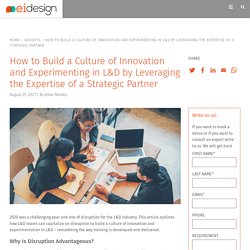
This article outlines how L&D teams can capitalize on disruption to build a culture of innovation and experimentation in L&D – remodeling the way training is developed and delivered. Why Is Disruption Advantageous? Nature demonstrates that it’s not the strongest or swiftest that succeed – it’s those who are most adaptable. In business, adaptability is king – it trumps speed and strength. L&D teams are feeling increasing pressure to do more with less at a faster pace to keep up with the rate of change. While the pace of change is nothing new, L&D teams now have to accommodate more remote and hybrid workforces, the changing needs and desires of modern learners, and evolving technologies.
L&D teams need to seize the moment and drive innovation in L&D for which the disruptions of 2020 were the catalyst. Why Is Innovation in L&D Hard? Consider Kodak. How to Understand and Integrate Learner Needs into Your Training Programs. The significance of understanding and integrating learner needs into corporate training programs is well established.
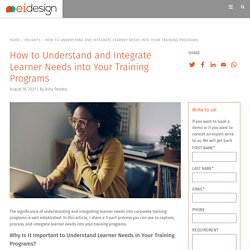
In this article, I share a 3-part process you can use to capture, process, and integrate learner needs into your training programs. Why Is It Important to Understand Learner Needs in Your Training Programs? The changing work landscape, including remote work, highly mobile workforce, and increased social interactivity beyond traditional workplaces, makes it essential that organizations evolve their eLearning strategies to respond appropriately.
However, according to a Brandon Hall Group study, less than a quarter of organizational L&D strategies are effective in helping companies meet their business goals. One of the underlying issues for the ineffectiveness of training programs, especially as it relates to remote learning, is that organizations put “learning” as the sole desired outcome, while neglecting to integrate learner needs into their strategies. Parting Thoughts. 6 Must-Have Workplace Learning Strategies for the Hybrid Workplace. Globally, the workplace is transitioning to a hybrid model that will continue to have remote teams.

Training a hybrid workforce requires a new learning mindset. In this article, I share strategies for workplace learning with a hybrid workforce. What Is the Hybrid Workplace? The workplace of the future is hybrid – It implies a blend of in-office and remote employees, some of whom may even rotationally work in an office and remotely. This hybrid model implies that team members are geographically dispersed, even potentially spanning multiple time zones. This presents a host of challenges, many of which can be resolved with an effective hybrid workplace learning strategy and roadmap. Truly, the hybrid workplace existed before COVID forced most knowledge workers to engage remotely.
Now that a hybrid workforce is the recognized reality, many organizations have realized its potential to increase productivity, retain and entice top talent, as well as enhance workflows. How to Leverage the Expertise of an eLearning Solutions Provider. The pandemic has changed traditional learning paradigms.

In this article, I outline how you must evolve training strategy responses to deal with this new world and how the expertise of an eLearning solutions provider can help in this transformation. How the Pandemic Has Redefined the Workplace and Expectations from L&D Teams The pandemic has changed workplace dynamics to predominantly work from home (WFH). 7 Best Practices for Designing Accessible eLearning Training Programs. Businesses are now leaning toward Universal Design.
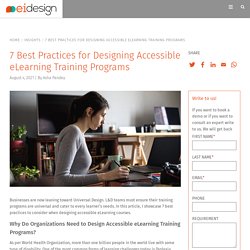
L&D teams must ensure their training programs are universal and cater to every learner’s needs. In this article, I showcase 7 best practices to consider when designing accessible eLearning courses. Why Do Organizations Need to Design Accessible eLearning Training Programs? As per World Health Organization, more than one billion people in the world live with some type of disability. 5 Strategies to Support the Application of Learning on the Job and Improve Employee Performance. Training must enhance employee performance.
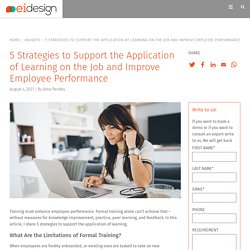
Formal training alone can’t achieve that – without measures for knowledge improvement, practice, peer learning, and feedback. In this article, I share 5 strategies to support the application of learning. What Are the Limitations of Formal Training? When employees are freshly onboarded, or existing ones are tasked to take on new responsibilities within the organization, the L&D team usually prescribes a set of trainings before they commence their new assignments. Compliance Training: Making Compliance Training More Strategic. Designing Accessible eLearning Courses with the POUR Principles of Accessibility. To create all-inclusive training programs and achieve the desired training results, businesses must adopt vital principles of accessibility.
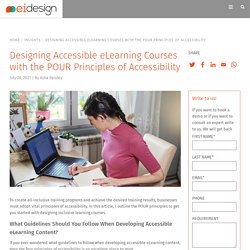
In this article, I outline the POUR principles to get you started with designing inclusive learning courses. What Guidelines Should You Follow When Developing Accessible eLearning Content? If you ever wondered what guidelines to follow when developing accessible eLearning content, then the four principles of accessibility is an excellent place to start. There are four overarching principles that provide a framework for your content throughout the writing, developing, and testing phases of your course.
They are Perceivable, Operable, Understandable, and Robust, or POUR in short. But before diving into the principles themselves, let’s get some context as to how these four principles came to be. How Are the POUR Principles Categorized Under the Web Content Accessibility Guidelines (WCAG)? Building a Growth Mindset and a Learning Mindset in Employees. Mindset is foundational to the success or failure of any organization.

This article explains why building a growth mindset is an important initiative for L&D teams and outlines strategies that will help create a learning mindset in employees. Why Is a Growth Mindset So Important? Why Should You Outsource eLearning Content Development in the New Normal. To successfully navigate the rapid pace of change, organizations must leverage outsourcing partnerships.
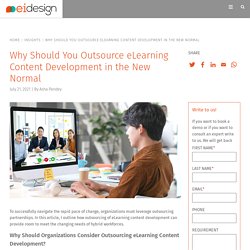
In this article, I outline how outsourcing of eLearning content development can provide room to meet the changing needs of hybrid workforces. Why Should Organizations Consider Outsourcing eLearning Content Development? To successfully handle the changing dynamics of business today, firms are finding that effective partnerships are a must. How L&D Teams Can Leverage Strategic Partnerships to Meet the Enhanced Expectations from the Business. How to Make a Business Case for Continuous Learning. Change is a constant force.
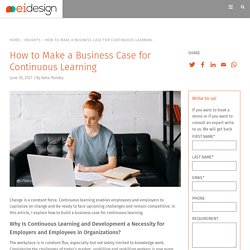
Continuous learning enables employees and employers to capitalize on change and be ready to face upcoming challenges and remain competitive. In this article, I explain how to build a business case for continuous learning. Why Is Continuous Learning and Development a Necessity for Employers and Employees in Organizations? The workplace is in constant flux, especially but not solely limited to knowledge work. Considering the challenges of today’s market, upskilling and reskilling workers is now more important than in the past. Those businesses who build a case for and follow through with a plan for continuous learning and development are more able to remain competitive. How to Make the Shift from Conducting Discrete Training Events to a Continuous Learning ProcessIntroduction.
Traditional training with a focus on largely discrete and disparate events lacks the effectiveness required for true behavior change. This article outlines how a continuous learning process, on the other hand, improves the application of learning and leads to behavior change. Why Should You Shift from Discrete and Disparate Training Events to Continuous Learning? In traditional training, learners attend training sessions – either synchronous or asynchronous – sometimes with groups of peers or on their own. The events take place outside the work environment and lack the opportunity for application and don’t lead to true behavior change. How to Ensure Learning has a Positive Impact on Performance. 9 Strategies to Deliver Great Learner Experiences and Learning Experiences in Your L&D Programs.
L&D professionals sometimes misunderstand the subtilities of learner and learning experiences. In this article, I outline what each aspect signifies, what are the differences, and share strategies using both to create effective learning programs. What Is the Learner Experience? The world has seen an expansion to virtual working and learning. If you ask typical eLearners what their “experience” has been with a course, they’ll likely talk about what they learned and how much they liked (or disliked!) What was taught. Their likes or dislikes about certain aspects of learning are only part of – but not the entirety of a learner’s experience. In fact, learners’ experiences encompass more than just what they learned. How to Personalize Upskilling and Reskilling Programs at Scale. Strategies to Enhance the Impact of Storytelling in eLearning – 3 Examples.
Though less used, storytelling in eLearning can create powerful, engaging experiences – leading to sticky learning. In this article, I outline how microlearning, gamification, scenarios, and branching simulations can help you unleash its power. Why Is Storytelling in eLearning a Great Fit for Training in the New Learning Environment? Learner engagement is a key element of any eLearning program. With so many employees now working remotely – facing diverging work and personal priorities, getting them engaged in eLearning is often a challenge. How to Build an Army of Lifelong Learners in Your Organization. Organizations comprising lifelong learners adapt faster to dynamic exigencies and innovate solutions for previously unrecognized markets.
This article explains why learning must be an enterprise priority and outlines ways to build lifelong learners. Why Should Continuous Learning and Development Be a C-suite Priority? From both the employer and the employee perspective, there are a number of reasons that C-Suite should make L&D an ongoing priority. For established firms, the ability to learn and adapt to change is at the core of success in business.
Otherwise, upstart firms will identify and service formerly unrecognized needs and markets and replace incumbent firms. Learning Strategy: Learning Needs to Drive Organizational Performance. How to Ensure Learning has a Positive Impact on Performance. Cracking the Code – How to Measure and Maximize the Business Impact of Your Corporate Training Programs. Every year organizations make significant investments in employee training programs. More often than not, their effectiveness is measured largely through basic L&D metrics that includes basic parameters like the number of employees who took the training, the lead time for completion, and assessment scores.
However, what tends to not get validated is the impact of the training on business Key Performance Indicators (KPIs). The KPIs may not have been captured during the TNA phase, or even when the KPIs were identified, their measurement framework may not have been in place. How to Plan and Strategize Successful Remote Employee Training Programs in 2021. A major takeaway from 2020 is that the L&D team’s ability to concentrate on learner requirements and strengthening corporate strategy and tactics is vital for success.
Equipped with the experience of 2020 and a strong need to associate to the new normal, the training and development planning for 2021 should center on the following: How to Engage Your Learners in the Remote Workplace Through Immersive Learning Strategies. eBook Trilogy - Elevating Remote Learning Programs. How to Drive Continuous Learning Outside the Formal Training Environment. Combating the Learner Engagement Challenge by Creating Immersive Learning Experiences. The current work from home (WFH) dynamics is one replete with distractions that erode learner focus during virtual training. In this article, I outline how L&D teams can use immersive learning to address the challenge of learner engagement.
The Learner Engagement Challenge Changes in workplace dynamics, where more employees work from places other than their traditional workplaces, has produced wide-ranging anxiety and distractions in the workforce. Strategies to Drive Self-Directed Learning in the Remote Workplace. How to Create Learning Journeys that Improve Employee Performance. 8 Strategies to Integrate Experiential Learning in Training Programs. Experiential Learning (EL) develops skills to expedite on-the-job performance improvement. Not well understood, the L&D teams don’t widely practice it. Redefining the Purpose of Learning and Development - Aligning L&D Strategy to Business Performance. How to Multiply the Impact of Videos in Training with Learning Ecosystem. During the pandemic, video consumption gained traction, and L&D teams seek ways to tap videos effectively for training.
In this article, I show how you can multiply the impact of videos for training through a Learning and Performance Ecosystem. Leveraging Training Needs Analysis Phase to Measure the Business Impact of Training. It’s time to reevaluate Training Needs Analysis (TNA)! Instead of targeting just learning outcomes, leverage the TNA phase to help you determine the actual business impact. Creating a Connected Learning Solution by Supporting Your Formal Training with Informal Learning. Learning in any organization is the base on which creativity, innovation, and strong execution is built. Strategies to Drive Self-Directed Learning in the Remote Workplace. Strategies to Bridge Workforce Skills Gap with Digital Learning Programs.
Business continues to shift at an ever-increasing velocity. The skills required to be successful today are different than they were yesterday and will continue to change in the future – creating a skills gap. How to Leverage Social Learning to Support Remote Learning Programs. Key Considerations for Building Your Learning & Performance Ecosystem. Training the Modern Learner - Delivery Strategies and Content Formats that Work. Tips and Strategies to Demonstrate the Value of Your Training Programs. How to Use Gamification to Promote Active Learning in the Workplace. Leverage On-demand Learning to Step Up the Application of Learning. 6 Go-to Strategies to Transform Your Recorded VILT Sessions to Engaging Microlearning Modules. eLearning Trends in 2021 - Perspectives to Help You Reframe and Rethink Your Training Programs. Focus Areas for Training and Development Strategy Planning in 2021. Using Gamified Learning Approaches to Drive Employee Performance & Engagement.
Tips & Strategies to Identify the Right Training KPIs for Your L&D Programs. Drive Learner Engagement Through the Roof with Online Training Videos. FAQs on Video Based Learning in Corporate Training. Change Employee Behavior in the Workplace with These 5 High-impact Corporate Training Strategies - EI Design. 5 Amazing eLearning Video Strategies to Keep Your Digital Learners Hooked - EI Design. Futureproof Your Training with EI Design. Frequently Asked Questions (FAQs) on Virtual Training. How to Offset the Forgetting Curve in Your Employee Learning Programs with Microlearning. 7 Tips to Support the Delivery of Virtual Induction and Onboarding Training. Measuring the Business Impact of Training and Development Programs. Case Study - Instructor-Led Induction & Onboarding Training to Virtual Mode. How to Build Employee Learning Habits and Drive Continuous Learning in the Workplace with Microlearning.
Why You Should Use Blended Learning For Leadership Training Programs. How to Create an Online Sales Training Program for Remote Sales Team. Infographic 8 Best Practices for Virtual Induction and Onboarding Training. Gamify Your VILT Programs and Drive Remote Learner Engagement. Frequently Asked Questions (FAQs) on Gamification in Corporate Training. Frequently Asked Questions (FAQs) on mLearning in Corporate Training.
6 Strategies to Convert Instructor-Led Compliance Training to eLearning. FAQs on Blended Learning in Corporate Training. Employee Training Metrics to Measure Training Effectiveness and Impact. Game-based Learning Strategies to Drive Learner Engagement & Motivation. Remote Learning Assessment Strategy using Learning and Performance Ecosystem. Video: Blended Learning 2.0: Transforming Training for the New Workplace. Driving Informal Learning in a Remote Working Environment - Infographics. How to Identify the Right Training KPIs for Your Learning and Development Programs. Examples of Using Blended Learning 2.0 Approach for Corporate Training.
Infographic Microlearning to Promote Learning in the Flow of Work. 8 Training Content Development Strategies for Remote Employee Training. Frequently Asked Questions (FAQs) on Microlearning in Corporate Training. Rapid eLearning Development To Maximize Your Training Budget. Game-based Learning to Drive Learner Engagement and Motivation.
How to Drive Just-in-time Learning with Performance Support Tools. 3 Microlearning Strategies to Promote Learning in the Flow of Work. Moodle. Moodle. 5 Types of mLearning To Use in Your Training and Development Programs. 5 Strategies to Maximize and Measure the Impact of Training Programs. Create Compelling Compliance Training with Scenario Based Training. Measuring the Business Impact of Your Training & Development Programs. Strategies to Design a High-impact Virtual Learning Journey. Strategies to Drive Informal Learning in a Remote Working Environment. Tips and Strategies to Engage Remote Learners Through Virtual Training. Moodle.
5 Types of mLearning To Use in Your Training and Development Programs. 5 Strategies to Maximize and Measure the Impact of Training Programs. Create Compelling Compliance Training with Scenario Based Training. Measuring the Business Impact of Your Training & Development Programs. Strategies to Design a High-impact Virtual Learning Journey.
Strategies to Drive Informal Learning in a Remote Working Environment. Tips and Strategies to Engage Remote Learners Through Virtual Training. Moodle. 6 Steps for the Digital Transformation of Your Corporate Training Programs. 6 Immersive Self-paced Learning Strategies for Virtual Training Programs.